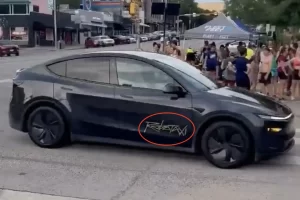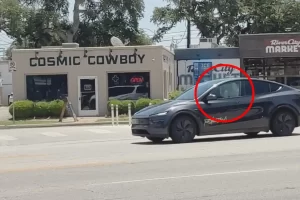- 🚗 Tesla plans to produce Cybercabs that do not have a steering wheel or pedals, aiming for a fully autonomous experience.
- 🛠️ Production will begin at Giga Texas, sharing parts with Model 3 and Model Y for efficiency.
- 📸 The Cybercab will include a front bumper camera similar to the Cybertruck’s, maintaining compatibility with other Tesla vehicles.
- ⚙️ Teslas with Hardware 3 or 4 can operate as robotaxis without needing hardware upgrades.
- 🔍 The Cybercab will not include Tesla logos, relying on design recognition for brand identity.
- 💡 Interior features just three buttons; other functions are managed via touchscreen to simplify the design.
- ⚡ Inductive charging might help reduce production costs by using fewer materials.
In the rapidly evolving landscape of transportation, Tesla continues to be at the forefront of innovation. The unveiling of the Tesla Cybercab Robotaxi at the recent “We, Robot” event has set the stage for a revolution in how we perceive urban commuting. As the world edges closer to fully autonomous vehicles, Tesla’s Cybercab presents a compelling vision of the future. Let’s delve into the key details and implications of this groundbreaking development.
Tesla’s Vision: A Fully Autonomous Experience
Tesla’s Cybercab Robotaxi represents a pivotal shift towards a fully autonomous driving experience. The Cybercab is designed to operate without a steering wheel or pedals, underscoring Tesla’s commitment to revolutionizing commuter travel. By removing these components, Tesla emphasizes its focus on creating a sleek, minimalistic design while optimizing space and comfort for passengers.
Key Features of the Tesla Cybercab:
- Autonomous Design:
- The absence of a steering wheel and pedals highlights Tesla’s dedication to autonomy.
- Focus on providing a seamless and user-friendly experience for passengers.
- Shared Production:
- Utilizes parts from Model 3 and Model Y to streamline efficiency.
- Production begins at Giga Texas, leveraging Tesla’s expansive production capabilities.
- Advanced Camera Integration:
- Equipped with a front bumper camera akin to the Cybertruck.
- Ensures compatibility and safety across Tesla vehicles.
Seamless Integration and Branding
A defining feature of the Cybercab is its compatibility with existing Tesla hardware. Vehicles equipped with Hardware 3 or 4 can transition into robotaxis without additional upgrades, showcasing Tesla’s forward-thinking approach and ensuring a smooth integration into current automotive line-ups.
Additionally, the Cybercab’s design eschews traditional branding methods. By omitting Tesla logos, the vehicle relies on its unique design for recognition. This unconventional approach speaks to Tesla’s confidence in its distinctive aesthetic and market presence.
Interior Innovation and Cost-Efficiency
The interior of the Cybercab strips complexity down to its essentials. With just three physical buttons, two for window operation and one for the dome light, the rest of the functionalities are accessed through an intuitive touchscreen interface. This layout not only simplifies user interaction but also reduces production costs and potential mechanical failures.
Furthermore, the use of inductive charging technology stands to significantly reduce material costs and enhance the sustainability of production processes. This energy-efficient model signals Tesla’s commitment to creating cost-effective and environmentally friendly transportation solutions.
The Grand Vision: A Look Ahead
Tesla’s Cybercab is more than just a vehicle; it’s a glimpse into the future of urban mobility. With plans for mass production and the elimination of hardware redundancies, Tesla is set to redefine the landscape of autonomous driving.
Anticipated implications include:
- Reduced Traffic Congestion: Autonomous features can optimize traffic flow.
- Increased Safety: Advanced camera systems and software increase road safety.
- Economic Impact: Potential for increased demand in the autonomous ride-sharing market.





